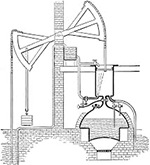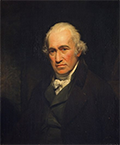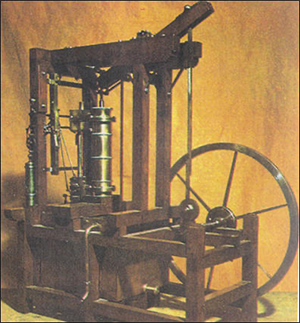|
The Industrial Revolution in Great Britain
Perhaps no invention more epitomizes the powerful innovations that took place during the Industrial Revolution than the steam engine. From its humble beginnings, the steam engine, as perfected by the Scottish inventor James Watt, had factories humming all over Great Britain for many years. Watt wasn't the first to make such a machine, however. "Necessity is the mother of invention," someone once said. A necessity in the 17th Century was that the Europeans had taken to burning coal as fuel. Demand for coal was high, so people in England, especially, dug down deeper and deeper, in search of more and more coal. They dug down so deep and in so many places that they invariably encountered problems related to water. Water from the soil or water from rain got in the shafts and the mines, and they couldn't keep the coal dry. They wanted to get the water out of there but it was really far down and they decided that it wasn't exactly worth the effort to get it out one bucket at a time, lowered up and down by rope, like they'd been doing for centuries. So they wanted to find a way to get water out of the shafts and the mines relatively quickly so they could get more coal so they could power more things so they could make more money. Thomas Savery, an English engineer, crafted a machine that used a primitive engine to get the water out of a mine, using steam. Savery borrowed heavily from the French scientist Denis Papin, who envisioned a similar system using a cylinder and piston setup. Papin had created the world's first steam-powered pressure cooker, but Savery had something bigger and better in mind, and he had a patent for it in 1705. He referred to it as an "engine to raise water by fire." Savery's engine had two steam boilers, and the thing could run almost constantly. Savery's machine, however, didn't have enough power to go really down deep in the ground. 
Another Englishman, the blacksmith Thomas Newcomen, improved on Savery's machine in 1711, in effect creating a water pump that powered the water removal process. Newcomen's machine used atmospheric pressure to do the work. The engine pumped steam into a cylinder, cold water condensed the steam and created a vacuum and enough atmospheric pressure to operate a piston, which went downward and powered the engine. Newcomen's machine was incredibly successful and popular, but it was still an example of wasting energy. 
James Watt entered the picture in 1765, where he was working at the University of Glasgow. Someone had carted in a Newcomen machine that wasn't quite working right. When Watt set about repairing the machine, he had a revelation. He looks at the way the Newcomen machine works, at how the cylinder would run hot and then cold; during the cold bits, the cylinder had to be heated up again, wasting time and energy. Watt's idea was this: "What if the steam had a separate condenser, so the cylinder could remain hot? So he added a separate condenser and it solved the problem. Watt's new engine, with its separate cylinder, saved 75 percent of the fuel that Newcomen's machine had been wasting. He also did three other things that revolutionized the machine and paved the way for the Industrial Revolution: He made it possible for the piston to operate in both directions by allowing the steam in on either side; he introduced a flywheel, Before long, James Watt's engines were powering blast furnaces, textile mill machinery, and many other things. One engine was powering many, bringing the world into a new age. That flywheel, of course, was the progenitor of the railroad engine, the steamboat engine, even a steam-powered airship. James Watt described the power of his machine by calculating the number of horses it would otherwise take to do the same amount of work. The term he used for this was horsepower. Next page > Heavy metals > Page 1, 2, 3, 4, 5 |
|
Social Studies for Kids
copyright 2002–2025
David White



 which enabled a rotary motion that produced a more constant load; and he added a centrifugal governor, to control the speed.
which enabled a rotary motion that produced a more constant load; and he added a centrifugal governor, to control the speed.
